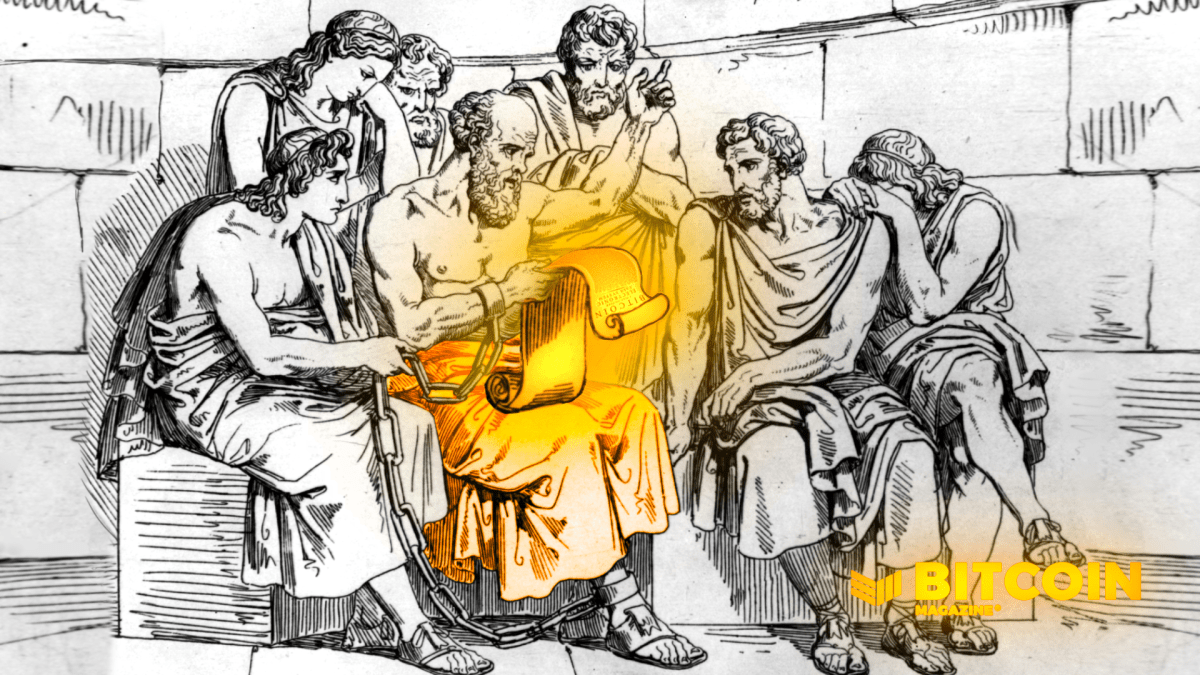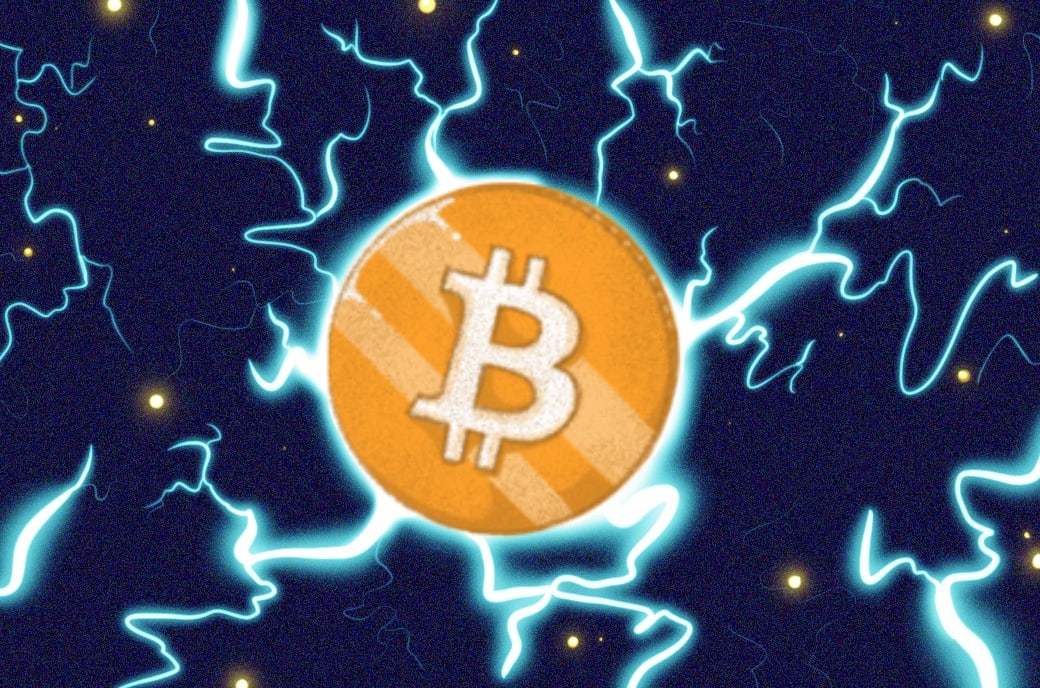Bitcoiner 2029: Another Ten Years On

The following is an imaginative, fictitious account of what the world could look like in 2029 and how Bitcoin might evolve to revolutionize economic, monetary and free-market systems. Unfortunately, time machines haven’t been invented in this speculative future so we couldn’t verify the accuracy of the narrator’s experience — please take the following story with a healthy grain of idealistic salt.
As I walked out on the tarmac, the West Coast winter climate, brisk and sharp, broke over me. The sun set over the west bay in a splendor of sherbert radiance. Some 20 miles away, I envisioned the sepia luster of the Golden Gate stretching across the bay, that bastion of 20th century industry blending with the gradually darkening backdrop of the day’s paling light.
Immediately I was taken back to my first crypto conference in the Bay Area some 11 years earlier — right on the brink of the crypto craze of 2017. A fledgling industry, we found ourselves positioned in an ecosystem that was challenging the economic norm with feverish and diehard persistence. Bitcoin was a revolution, and we were accelerating a movement that would disrupt the monetary realm as we knew it. It was a thrilling time; we were building the future.
Now, the same flutters of excitement I experienced in 2017 morphed into the euphoria of triumph. The future we imagined — we had built it.
An act of happenstance, the consequence of this triumph greeted me as I stepped from the tarmac into the warm, aseptic fluorescence of the SFO airport. Greeting me at the door like a stalwart guardian of old, its paint peeling and brittle from lack of care, a defunct currency exchange booth sat like the gutted relic of a different time.
The sight conjured memories of my childhood, when my father would vent about the fees charged for currency conversion at these booths.
“12 percent?” he’d say in disbelief. “It’s straight theft! Should have done it beforehand at the bank — of course, their rates are about as bad though,” he always conceded.
I laid my hand on the jaundiced linoleum countertop.
“You put up a good fight, old boy,” I muttered, giving the booth a sympathy pat.
A janitor within earshot looked up from the tile floor he was tending and flashed me a dubious look, complete with cocked eyebrow.
“Sorry, just reminiscing,” I replied awkwardly.
Gathering my composure, I headed to the baggage claim, collected my luggage and proceeded to the rideshare section of the terminal. I opened my Decentralift app and requested a car.
Standing in wait for my ride, I surveyed the news for the day on my BitLive app.
The New York Times: January 3, 2029: “In the New Year, POTUS, Congress Wrestle With New Economy”
The Wall Street Journal: January 3, 2029: “Investment Banks Faces Bankruptcy as Wall Street Debt Crisis Worsens”
Bitcoin Magazine: January 3, 2029: “China and Russia’s Mining War With the West Is About to Get More Entrenched”
Millennial Daily: January 3, 2029: “EU Parliament Convenes Emergency Session in Shadow of Global Economic Downturn”
The Times: “Pressure On: Parliament on Brink of Passing Crypto Tender Bill in Wake of EU’s Adoption”
I paid 1,000 sats for the NYT’s headliner, and I even shelled out for The Times article too, mainly for sentimental reasons.
Standing in waiting for my ride, I opened the NYT article and started reading.
Newly re-elected President Ables and the Democratic-controlled Congress continue to look down the barrel of a currency crisis as long-standing Wall Street Institutions like Goldman Sachs and J.P. Morgan continue to fold under the pressures of bankruptcy.
These closures are the climax of a financial paradigm shift that began when Congress passed the “Cryptocurrency Tender Recognition Act” of 2027, legislation that categorizes cryptocurrencies such as bitcoin as legal tender under U.S. law. The law was prompted by the surging demand for bitcoin and other private currencies by U.S. employees and a wave of adoption as major brands, such as Apple, Amazon, Walmart, Nike and others began accepting bitcoin and other cryptocurrencies as a sole method of payment.
Congress is meeting with the President and the Federal Reserve, as well as CEOs from the nation’s largest private banks, on Thursday to discuss the crisis and break ground on a relief plan.
“The COIN Act was a safety-net plan of sorts. It outfitted the United States with the most powerful mining operation on the planet, and we’ve been actively liquidating portions of our precious metal reserves in favor of bitcoin and other cryptos,” House Banking Committee Chair Vicente González told the New York Times.
“Still, the Thursday meeting is critically important. We also recognize the need to aid these financial institutions for the betterment of our economy and constituents as we confront a paradigm shift in monetary policy.”
Representatives from Goldman Sachs, J.P. Morgan and the Federal Reserve declined the New York Times’ request for comment.
“Long time coming,” I muttered to myself.
European change was underway too, with the EU Parliament just recently voting to recognize bitcoin as legal tender. The legalization was, in part, encouraged by the actions of member states like Germany, France, Norway and Spain passing individual legislation to give cryptocurrencies status as legal tender as the euro’s popularity continues to peter out.
The rest of the EU will have some catch-up to play, though, I mused. Scandinavian countries (taking a bit of a cue from Canada) began establishing gargantuan mining farms in the early ’20s, making good use of the abundance of renewable energy these countries have produced with hydroelectric dams. No doubt that’ll cut into what González called “the most powerful mining operation on the planet.”
Not to mention that the resources Russia and China have been pouring into mining industries and the escalation of what’s shaping up to become a multinational, multi-decade mining war. Now that crypto is becoming the monetary standard for international trade, this ain’t your granddaddy’s trade war. What’s to come will make the Trump-era embargoes look like a training exercise.
I was about halfway through the article when my Decentralift pulled up. “Mike. B.’s Black 2027 Tesla Model S has arrived,” my phone chimed.
Using my Watchlet smart watch, I scanned a QR code on the outside of the backseat door handle, the RSK smart contract immediately unlocked the door, and I hopped in.
“Welcome to Mike B.’s self-driving car, Colin Harper!” the car grated, my name itself distinguished by that strange, too-mechanical accent when the AI jumps from its library of set phrases to something variable like a new passenger’s name.
“Thank you for choosing Decentralift today. Thanks to your dedication to responsible ridesharing, you’ve saved 2.14 grams of CO2 emissions.”
As the self-driving car drove on, a decade of perspective became my rearview. The first go-around, my Lyft fare was roughly $35 from the airport to my lodging at The Red Victorian. This time, my Decentralift was 14,000 sats.
I reviewed Mike B.’s reputation ratings on the Decentralift app. Mostly good — a 4.2 rating. A common qualm: riders complained that Mike’s car had an uncanny odor to it, a miasmic mixture akin to chlorine and pine-scented air fresheners. Many found it overbearing. My guess was that Mike was somewhat of an OCD neatfreak, probably cleans his car obsessively to rid it of the invisible remnants of the unknown strangers that use his vehicle each day.
A copy of Time magazine sat for leisure reading in the back pouch of the driver’s seat, and the very humanizing gesture struck me as playfully ironic coming from an autonomous vehicle. “From Renegades to Revolutionaries: How Bitcoin’s Earliest Evangelists Built Crypto Empires in the Shadows of Suspicion,” the cover read.
A decade ago, some outsiders might have called our work groundbreaking, and some still might have called us revolutionaries. Most of those willing to give the industry a pat on the back and a gold star were those already working in it. Even those who thought that there was good work to be done were somewhat skeptical.
But to many, we were rebels — or worse: anarchists, outcasts, basement dwellers, drug dealers, fraudsters, dark-web peddlers, money launderers, degenerate gamblers, tax evaders. Our currency was baseless, our intentions were unscrupulous, our technology was overhyped and our vision was dangerously contrarian.
Back then, the New York Times was publishing articles like “Everyone Is Getting Hilarious Rich and You’re Not”; now on the front page are stories about how bitcoin and crypto have begun to topple a nearly century-old fiat economy. Then, Nobel Prize economist Robert Shiller was calling it “an interesting experiment, but … not a permanent feature of our lives”; in 2028, Satoshi Nakamoto was the first pseudonymous/anonymous person(s) to be awarded the Nobel Prize in Economics.
Out the right-hand window, a stretch of Bitcoin and crypto-related billboards advertised the very companies that those revolutionaries had built.
“No internet? No problem! Run a full Andromeda Node right from your mobile device to send and receive payments anytime, anywhere using Blockstream’s Bitcoin Satellite. To learn more, visit blockstream.com/satellite.”
Another board branded with the tagline, “Your data. Your content. Your value. Reclaim your online independence with Bitlive.” On it, a knight clad in binary code chainmail wielding a Bitcoin shield, defending against a dragon, blasting the shield with breath that appeared to consist partly of Terms of Use legal language.
I chuckled a bit to myself, calling to mind the inexhaustible list of ICOs and token projects that tried to solve the content monetization problem. Didn’t need a utility token for that. The irony that the billboard, in part, is a stand-in for the industry that BitLive replaced also struck me as good fun.
The rest of the drive was filled with physical reminders of the space’s progression. They rolled on, exit to exit, in the forms of billboards and company names emblazoned on the tops of skyscrapers. At one point, Zug, Switzerland, had earned the moniker Crypto Valley for the density of crypto companies attracted to the region for its accommodating legislation. Silicon Valley had caught up, along with plenty of other crypto hubs: Toronto, Canada; Vaduz, Lichtenstein; Seoul, South Korea; and others.
Our “far-flung” visions were materializing.
Renegades to revolutionaries.
I reached the Intercontinental a little before 6:00 p.m.
“Thank you for choosing Decentralift today, Colin,” the AI droned. “Would you like assistance with your luggage?”
“No, thanks,” I replied and grabbed my carry-on bag.
Walking into the hotel, I checked my reservation details on my watch and made straight for my room on the 21st floor. Beside the elevator was a conference banner, one of many on display throughout the hotel.
“Welcome to Bitcoin 2029: The Premier Bitcoin Conference” it read. Below was an impressive list of speakers, some highly respected, old standards, others exciting new voices.
Andreas Antonopoulos was coming out of a hard-earned sabbatical. This was the first conference he’d be keynoting since 2026. Samantha Styles, who had made her name during the Hard Fork Wars of 2025, would be speaking on “Crises in Consensus and the Importance of Decentralized Governance.” Elizabeth Stark, Colter Simpson, Gail Tenpenny, Adam Back, Preethi Kasireedy and Jun Li were all giving tech demonstrations. Even Roger Ver was speaking, having come back to the Bitcoin community following the Bitcoin Cash Chain Split of 2018 and a five-year journey of introspection.
Reaching the 21st floor, I found my room and unlocked its door with my Watchlet. The room featured an expansive view of the city. Surveying the sprawling cityscape, I noticed a massive crowd of protesters concentrated in the Yerba Buena Gardens. The throng was spilling over from the adjacent Moscone Convention Center, pouring onto Howard Street and clogging its throughway to the detriment of any potential traffic — and to the detriment of attendees of the World Banking Expo, which was taking place in the convention center.
“Maybe Caleb is among them,” I wondered.
Cousin Caleb stayed on my mind as I left the hotel for a grocery run. A crypto donation center directly outside the entrance to the Intercontinental made his situation all the more poignant. I made my way to the burnt-orange box, no bigger than the neglected ATMs (bitcoin or traditional) whose ubiquitous uselessness still littered cities around the globe.
These donation centers dated back to the early ’20s, the project of an anonymous-yet-steadfast group of crypto philanthropists, but it wasn’t until the recent debt/monetary crises that they began propagating in record numbers overnight.
They were built to redistribute crypto wealth to nocoiners and those without proper access to bitcoin, people like Caleb. Caleb did put money into the ecosystem — he just put it in the wrong places. Like many others, he accepted his wages and converted paper into stablecoins. But he didn’t buy anything like Dai or an algorithmic-backed coin — he put his money into fiat-collateralized coins.
Cue the rapid devaluation of the dollar and the international monetary crisis. Hyperbitcoinization has been great for those of us who saw it coming, but it’s been painful for others and there’s plenty of work to be done to iron out the economic disparities.
I expect we’ll see many more protests like the one obstructing the World Banking Expo in the next decade, I thought, scanning my Watchlet to donate 0.0025 BTC to the cause.
As I stepped into the Locavore supermarket near my hotel, it made me grateful that not every service was exclusively online yet. Some IRL experiences can’t be beat, I thought.
Gathering my groceries, I checked the tracking information for each item on the blockchain. Now, it was easy to tell if a store was misrepresenting a product’s origin and whether or not its attributes, organic or otherwise, were correct. Locavore rarely faltered in its mission to provide “transparent and locally sourced food,” but I checked anyway — it was always entertaining to map the network of farms the food came from.
Perusing the aisles, certain items shared a bitcoin and USD price tag; others had their USD price tags removed entirely. I was a bit shocked to see USD denominations at all, but rationalized that slowly tapering off the dollar was probably a responsible move on the store’s part.
I proceeded to the checkout.
“Welcome, valued customer.” The self-checkout’s chipper tone belied in its automated voice. After I finished scanning my items, it asked if I would like to round up my purchase to donate to Crypto Giver, the same organization behind the donation boxes. Acquiescing, I paid and headed back to my hotel.
I made my way to the bar to grab a beer and prep for a panel I was moderating: “Banking the Unbanked and Unbanking the Banked: What Two Decades Have Meant for Adoption.” In the late ’10s, Bitcoin’s utility was on display in countries like Venezuela, Iran and Turkey. But the sudden onslaught of the Second Great Depression would give the first world a taste for what a decentralized monetary system meant for an economy entrenched in rampant inflation and debt-riddled chaos.
Maybe you think I’m being hyperbolic, but it wasn’t until a global economic crisis on par with (or more extreme than) the Great Recession that bitcoin could be truly battle tested. Satoshi created it in response to ubiquitous market disaster, but it would take another disaster (in part, incited by the same problems as the first) for the currency to function holistically as Satoshi intended: a global, permissionless currency that, freed from the centralized control of a monolithic entity, could flourish for the people as a hedge against inflation and monetary instability.
I ordered a stout as these thoughts crossed my mind and made their way into my notebook. The bar used the Andromeda satellite network to let me pay from my tab without having to connect to the internet, something that still blows my mind as I think back to the early days of Lightning.
Finishing my stout, I thought about some of the changes the last 10 to 15 years had seen: from layer 1 to layer 2 solutions, from lightweight wallet clients to lightweight nodes on smartphones, from Lightning to Andromeda, from basic payments to everyday smart contracts. What was originally a case for digital cash and a deflationary economy had put down its roots in the free market and grown into an ubiquitous, decentralized economy.
During my first trip to San Francisco, bitcoin was known only through hype and still regarded as a fringe technology. Now, it was changing how we interacted with everything: donations, groceries, hotel reservations and rideshares. It had become bigger than those skeptics could fathom and even bigger than what its early proponents could dream.
Leaving the bar, I made my way to a 7:30 speakers’ dinner at Cheekwood, the first restaurant in the U.S. to begin accepting crypto only as a payment method.
Just like the space’s early adopters, Cheekwood was mocked by food critics and related media. It wouldn’t last the month, they sneered. “Probably the most idiotic decision in San Francisco dining history,” one critic wrote.
But it thrived, and it has become a watering hole for crypto enthusiasts ever since.
It was all too fitting, then, that we chose to break bread at Cheekwood the eve before the conference. Far from a last supper, the meal personified all that the industry had been through in its two decades of existence: ingenuity, mockery, persistence and victory.
The decentralized future had won out.
This article originally appeared on Bitcoin Magazine.









